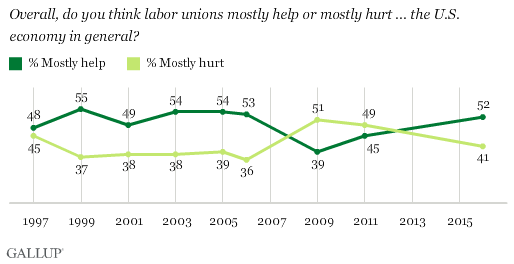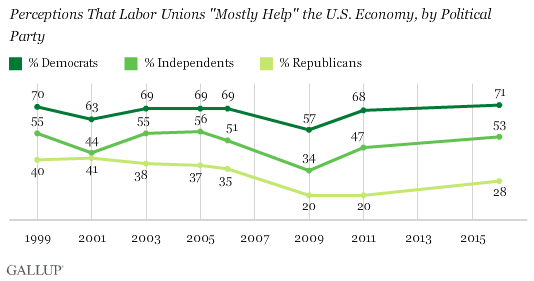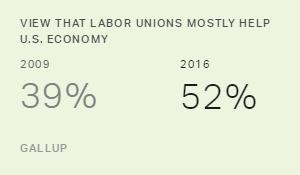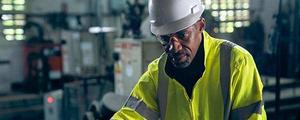Story Highlights
- 52% say unions help the U.S. economy, 41% say they hurt it
- In 2009, 39% said unions help the economy; 51% said they hurt it
- 56% approval of unions still below the historical norm
PRINCETON, N.J. -- A slim majority of Americans, 52%, say labor unions mostly help the U.S. economy, while 41% believe unions mostly hurt it. After a sharp 14-point decline between 2006 and 2009 in the percentage of Americans who believe unions mostly help the economy, public opinion is essentially back to what it was before the recession.

Democrats, Republicans and independents became less optimistic about unions' effect on the economy during and after the Great Recession, but all three groups have grown more positive. Republicans, the group showing the least amount of faith in unions' ability to help the economy, have not quite recovered to their pre-recession levels, but independents and Democrats have. Currently, 71% of Democrats, 53% of independents and 28% of Republicans believe unions mostly help the economy.

The results are based on Gallup's annual Work and Education poll. In this year's poll, conducted Aug. 3-7, Gallup asked Americans for the first time since 2011 to assess unions' effect on the U.S. economy, on unionized companies, and on union and nonunion workers.
Americans are most likely to say unions mostly help union workers themselves -- 70% hold this view. That is nearly twice the percentage who say unions benefit workers who are not members of unions (38%). Fifty-five percent say unions mostly help companies where workers are unionized, similar to the 52% who say unions benefit the U.S. economy.
| Mostly help | Mostly hurt | ||||||||||||||||||||||||||||||||||||||||||||||||||||||||||||||||||||||||||||||||||||||||||||||||||
|---|---|---|---|---|---|---|---|---|---|---|---|---|---|---|---|---|---|---|---|---|---|---|---|---|---|---|---|---|---|---|---|---|---|---|---|---|---|---|---|---|---|---|---|---|---|---|---|---|---|---|---|---|---|---|---|---|---|---|---|---|---|---|---|---|---|---|---|---|---|---|---|---|---|---|---|---|---|---|---|---|---|---|---|---|---|---|---|---|---|---|---|---|---|---|---|---|---|---|---|
| % | % | ||||||||||||||||||||||||||||||||||||||||||||||||||||||||||||||||||||||||||||||||||||||||||||||||||
| Workers who are members of unions | 70 | 24 | |||||||||||||||||||||||||||||||||||||||||||||||||||||||||||||||||||||||||||||||||||||||||||||||||
| The companies where workers are unionized | 55 | 39 | |||||||||||||||||||||||||||||||||||||||||||||||||||||||||||||||||||||||||||||||||||||||||||||||||
| The U.S. economy in general | 52 | 41 | |||||||||||||||||||||||||||||||||||||||||||||||||||||||||||||||||||||||||||||||||||||||||||||||||
| Workers who are not members of unions | 38 | 54 | |||||||||||||||||||||||||||||||||||||||||||||||||||||||||||||||||||||||||||||||||||||||||||||||||
| Gallup | |||||||||||||||||||||||||||||||||||||||||||||||||||||||||||||||||||||||||||||||||||||||||||||||||||
Americans' opinions of whether unions help unionized companies, union workers and nonunion workers all declined slightly in 2009 during the recession by four or five percentage points each. Those are much smaller declines than the 14-point drop in assessments of whether unions mostly helped the U.S. economy during the same year. The public's views of labor unions' effect on workers and companies are similar now to what they were before the recession.
Labor Union Approval at 56%
Americans have long approved of labor unions, including the 56% majority in the latest poll. Gallup first asked Americans whether they approved or disapproved of labor unions in 1936; since then, approval has averaged 62%, indicating Americans' current approval rating is below the historical norm.
Union approval fell to an all-time low of 48% in 2009 and has recovered modestly since then, though it has yet to reach the 59% it held in the last pre-recession reading. Americans were also less approving of unions when the economy declined in the late 1970s and early 1980s. Union approval reached its high points of 75% in 1953 and 1957 Gallup polls.

One reason recent opinions on unions have remained less positive than in the past is that Republicans have become increasingly negative toward them. Currently, 32% of Republicans approve of unions, compared with an average 43% approval from 2001 to 2007. Democrats' and independents' current approval ratings of unions -- 78% and 57%, respectively -- are essentially unchanged from 2001 to 2007 averages (76% of Democrats and 59% of independents).
Implications
Americans have historically evaluated unions more positively than negatively, a trend that continued even as union membership in the U.S. declined significantly in recent decades. It wasn't until the Great Recession that union approval dropped below the majority level and Americans' assessments of unions' effect on the economy, workers and companies also grew more negative at that time.
Now, Americans' opinions of unions have mostly recovered to what they were before the recession began. But their approval of labor unions remains slightly below pre-recession levels, largely because Republicans have become increasingly negative toward them. This is consistent with other trends toward greater partisan divides on political opinions such as presidential job approval and attitudes on policy issues such as global warming. That may make it difficult for labor union approval to return to the same level of support it enjoyed from the 1930s through the early 2000s, when approval ratings were mostly in the 60% range.
Historical data are available in Gallup Analytics.
Survey Methods
Results for this Gallup poll are based on telephone interviews conducted Aug. 3-7, 2016, with a random sample of 1,032 adults, aged 18 and older, living in all 50 U.S. states and the District of Columbia. For results based on the total sample of national adults, the margin of sampling error is ±4 percentage points at the 95% confidence level. All reported margins of sampling error include computed design effects for weighting.
Each sample of national adults includes a minimum quota of 60% cellphone respondents and 40% landline respondents, with additional minimum quotas by time zone within region. Landline and cellular telephone numbers are selected using random-digit-dial methods.
View survey methodology, complete question responses and trends.
Learn more about how the Gallup Poll Social Series works.


